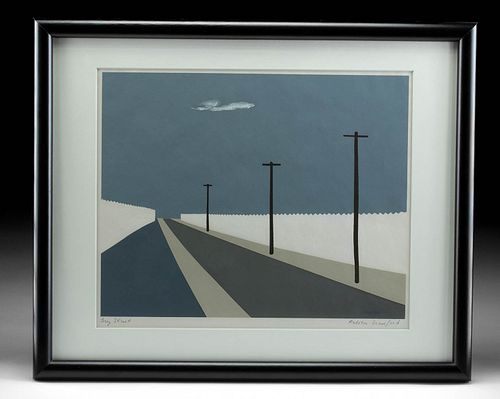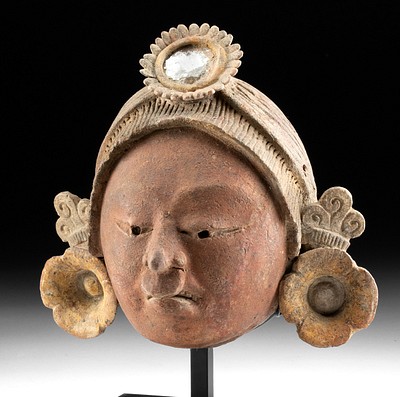Ralston Crawford Screenprint, Grey Street ex Christie's
Lot 193c
About Seller
Artemis Gallery
686 S Taylor Ave, Ste 106
Louisville, CO 80027
United States
Selling antiquities, ancient and ethnographic art online since 1993, Artemis Gallery specializes in Classical Antiquities (Egyptian, Greek, Roman, Near Eastern), Asian, Pre-Columbian, African / Tribal / Oceanographic art. Our extensive inventory includes pottery, stone, metal, wood, glass and textil...Read more
Categories
Estimate:
$4,000 - $6,000
Absentee vs Live bid
Two ways to bid:
- Leave a max absentee bid and the platform will bid on your behalf up to your maximum bid during the live auction.
- Bid live during the auction and your bids will be submitted real-time to the auctioneer.
Bid Increments
| Price | Bid Increment |
|---|---|
| $0 | $25 |
| $300 | $50 |
| $1,000 | $100 |
| $2,000 | $250 |
| $5,000 | $500 |
| $10,000 | $1,000 |
| $20,000 | $2,500 |
| $50,000 | $5,000 |
| $100,000 | $10,000 |
| $200,000 | $20,000 |
About Auction
By Artemis Gallery
Jul 14, 2022
Set Reminder
2022-07-14 10:00:00
2022-07-14 10:00:00
America/New_York
Bidsquare
Bidsquare : Exceptional Antiquities Ethnographica Fine Art
https://www.bidsquare.com/auctions/artemis-gallery/exceptional-antiquities-ethnographica-fine-art-9692
Museum-worthy examples of classical antiquities (Egyptian, Greek, Roman, Near Eastern), Viking, Far East / Asian, Pre-Columbian, African / Tribal, Oceanic, Native American, Spanish Colonial, Fossils, Ancient Jewelry, Fine / Visual Arts, so much more! Artemis Gallery info@artemisgallery.com
Museum-worthy examples of classical antiquities (Egyptian, Greek, Roman, Near Eastern), Viking, Far East / Asian, Pre-Columbian, African / Tribal, Oceanic, Native American, Spanish Colonial, Fossils, Ancient Jewelry, Fine / Visual Arts, so much more! Artemis Gallery info@artemisgallery.com
- Lot Description
Ralston Crawford (American, 1906-1978). "Grey Street" screenprint in colors, 1940. Hand signed and titled in pencil in lower margin. An outstanding impression of this early print of "Grey Street" by Ralston Crawford, replete with vibrant imagery and strong coloration. The scene is rendered in Crawford's classic Precisionist style, employing hard-edged abstraction to interpret his keen observations of the American landscape. Note how Crawford has eliminated any vehicles or pedestrians, and instead, has reduced the view to flat planes of color and minimalist silhouettes of the various elements, albeit with one exception, a lone painterly white cloud in the sky above. Size of image: 11.75" L x 14.75" W (29.8 cm x 37.5 cm) Size of frame: 17.625" L x 21.5" W (44.8 cm x 54.6 cm)
Ralston Crawford moved with his family from Ontario, Canada to Buffalo, New York when he was just four years old. Both his father and uncle were sea captains, and Ralston worked as a sailor on steamships traveling to Central America, the Caribbean, California, and New Orleans as a youth. In time he studied at the Otis Art Institute, Los Angeles, worked in Walt Disney's studio, and studied at the Pennsylvania Academy of Fine Arts and Barnes Foundation, Merion, Pennsylvania. Inspired by artists like Cezanne and Matisse who demonstrated a mesmerizing command of line and color, Ralston relocated to New York City in 1930 and became a rising star of the Precisionist movement, creating hard-edged, abstract industrial scenes. After traveling to Paris where he studied at Academie Colorossi and Academie Scandinave as well as Spain and Italy, he returned to the states to study at Columbia University. By the mid 1930s, Ralston lived in Chadds Ford and Exton, Pennsylvania, where he was captivated by the region's train stations, rural barns, and factories. He had his first solo exhibition at the Maryland Institute of Art in 1934, and his work began to receive favorable reviews from The New York Times and the New York Sun. In addition, Ralston taught at the Art Academy of Cincinnati, Buffalo Fine Arts Academy, the Brooklyn Museum School, the New School in New York City, and also made numerous trips to New Orleans to photograph the jazz musicians of that city.
Today, Ralston Crawford is known as one of the most important pioneers of Precisionism. He worked in various media - painting, silkscreen and graphic arts, sometimes incorporating photography or practicing photography as an abstract medium - creating striking mid-century compositions that were somewhat abstract and simultaneously employed his keen observations of the industrial landscape. Ralston Crawford's artworks are in important public and private collections, including the Museum of Modern Art, the Whitney Museum of American Art, and the Metropolitan Museum of Art.
Ralston Crawford's "Grey Street" realized $9,375 at Swann Galleries (Sale 2407 - Lot 307 - March 8, 2016).
Provenance: Private Boulder, Colorado, USA collection, acquired from Christie's "American and Modern Prints and Illustrated Books" - November 19, 1993, Lot 24
All items legal to buy/sell under U.S. Statute covering cultural patrimony Code 2600, CHAPTER 14, and are guaranteed to be as described or your money back.
A Certificate of Authenticity will accompany all winning bids.
PLEASE NOTE: Due to recent increases of shipments being seized by Australian & German customs (even for items with pre-UNESCO provenance), we will no longer ship most antiquities and ancient Chinese art to Australia & Germany. For categories of items that are acceptable to ship to Australia or Germany, please contact us directly or work with your local customs brokerage firm.
Display stands not described as included/custom in the item description are for photography purposes only and will not be included with the item upon shipping.
#170926Hand signed and titled by the artist in pencil/graphite in the lower margin. The artwork is set in a custom frame under glass and has not been examined outside the frame but appears to be in excellent condition save slight, nearly invisible surface scuffs.Condition
- Shipping Info
-
All shipping is handled in-house for your convenience. Your invoice from Artemis Gallery will include shipping calculation instructions. If in doubt, please inquire BEFORE bidding for estimated shipping costs for individual items.
-
- Buyer's Premium



 EUR
EUR CAD
CAD AUD
AUD GBP
GBP MXN
MXN HKD
HKD CNY
CNY MYR
MYR SEK
SEK SGD
SGD CHF
CHF THB
THB













